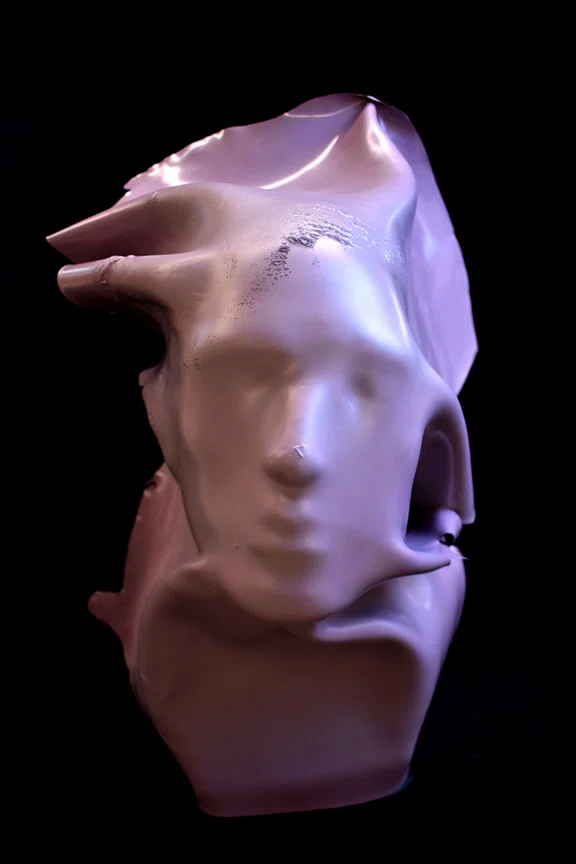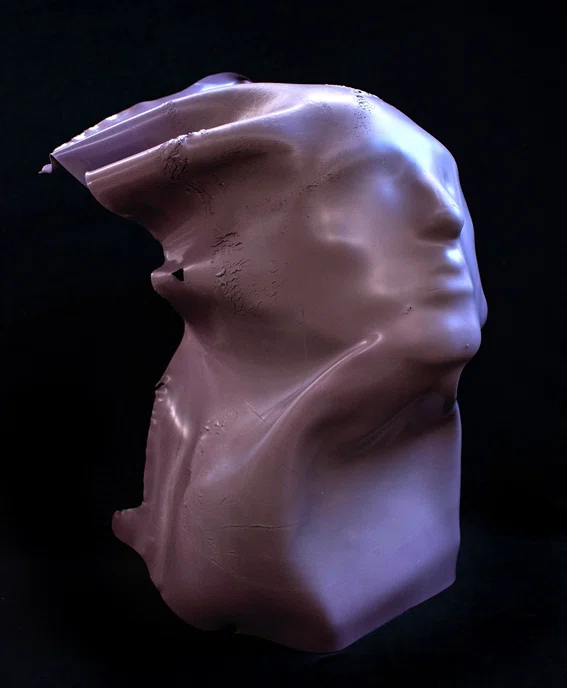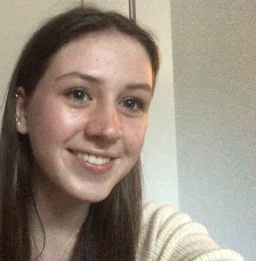




Sophia Perun
HANDSWORTH SECONDARY SCHOOL|North Vancouver BC, Canada
Teacher: Kory Bogen
3-D Art and Design

Wrinkle, View 1|17 x 7 x 15 in.
Ideas: paint represents aging skin pulled taught in a big wrinkle speaking to aging and beauty standards
Material(s): house paint, mannequin head
Process(es): dried house paint draped over mannequin used a blow dryer to mold to face

View 2
Student statement
Student
statement

Sophia Perun
My piece is called “Wrinkle." I explored my inquiry question; “How do we change as we age, and what do we fear about it?” I wanted to express how the skin changes as you get older and wrinkles form. In society, they are considered undesirable and ugly, something to be fixed with aging cream and botox. I think wrinkles are beautiful in the way that they tell your story, how much you have been happy, or focused or stressed in life. In this piece, the face is emerging from the wrinkle and is trapped behind it. The wrinkled skin is a barrier and pulled taught to eliminate any imperfection or crease. I used house paint to represent the skin. I poured the paint and dried it in a big sheet, then covered the bust and molded the face with heat. From making art this year I learned to not be hesitant or fearful, to instead experiment with materials and ideas. The best work I’ve made has come from taking risks. My art teacher always encourages us to push the creative boundaries and not shy away from the strange.
Teacher
statement
Kory BogEn
Working with Sophia for the past three years has been so rewarding – she is tenacious, conceptual, articulate, and willing to experiment. She completely understands the importance of revision, creating connections between her art-making and the real world, and involving the community in her practice. From Sophia, I learned that I need to let go and trust my students; her work is exceptional.
Sophia surveyed our school staff, asking for responses to her area of inquiry: “How do we change as we age, and what do we fear about it?” The portfolio was reflective, cohesive, compassionate, and humorous. Creating a survey is a great strategy to involve others in the portfolio, and to gather outside perspectives. Sophia is unafraid to take risks and ask – and respond to – tough questions. She is supportive of her peers and offers personal and global insight into the discussions we have as an ensemble of artists.
To start the program, I push my students to experiment first with materials and processes that they are unfamiliar with, and then to incorporate those new ways of working into their wheelhouse of skills. We generate originality in surface, texture, process, and construction in low-stakes experiments that are not assessed.
Our critiques are structured around ways to include materials and processes that achieve a synthesis of ideas and materials. This approach allows students to present their work and get feedback about achieving synthesis in the portfolio to push them over the edge from looking in from outside to jumping into a framework of how artists truly create works that reflect ideas. I ask students to talk about the work in the same way that they are expected to write about it. This helps to create a universal understanding in the classroom of how to compile the portfolio for submissions. Students also submit multiple written statements and we peer-edit them to gain insight into how others view the work in the portfolio, and to help articulate ideas within the framework of practice, experimentation, revision, and synthesis of ideas and materials.
A major strength in my program is having a professional roll printer that can reproduce student work. We document works (and works in progress) and then print out multiple copies on different papers, giving students the opportunity to try a variety of approaches to finishing the work (or taking it further), and to build an image bank that shows multiple examples of revision. Revision is important!
I heartily encourage all AP Art and Design teachers to attend an AP conference. Ask your school for the funds to send you to collaborate and listen to your colleagues from afar so that you can improve your teaching practice and better support your students. Seeing what other AP teachers are doing is massively helpful to build a community of empowered artists and to give students the ability to think freely, conceptually, and as innovative contributors to the world of art and design.
Principal
statement
Rupi Samra-Gynane
Read the transcript
Hi, I'm Rupi Samra Gynane, Principal of Handsworth Secondary in beautiful North Vancouver, British Columbia.

For my principal colleagues, I encourage you to expose every student to as many disciplines early on so they can find their passion. If you can find the resources for professional development or dedicate staffing to build up programs the investment will pay dividends for your entire school community.
A sincere congratulations to all of the artists and educators who have contributed to this exhibit.
Sophia Perun









